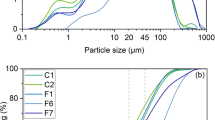Abstract
The use of fly ash in geotechnical engineering depends greatly on its pozzolanic reactivity. Though many factors influence the reactivity of fly ash it is well recognized that reactive silica and lime content play a major role. A new, accurate and reliable method for the determination of reactive silica content of fly ash has been established. The reactive silica content, obtained as acid soluble silica in about 2 to 3 N hydrochloric acid, is found to correlate well with unconfined compressive strength of fly ashes. The reactive silica content of fly ash is also important in the stabilization of soils using fly ash. © Rapid Science Ltd. 1998
Similar content being viewed by others
References
ASTM Designation: C 1084-92 (1995) Standard test method for Portland-cement content of hardened hydraulic cement concrete, Annual book of ASTM standards, Sec.4, Vol. 04.02, Americal Society for Testing and Materials, Philadelphia, PA, pp. 564-567.
Bell, F.G. (1988) Stabilization and treatment of clay soils with lime, Part 1 — Basic principles, Ground Engineering, 21, 10-15.
Cabrera, J.K. and Gray, M.M. (1973) Specific surface, pozzolanic activity and composition of pulverized fuel ash, Fuel, 52, 213-215.
Figg, J.W. and Bowden, S.R. (1971) The Analysis of Concrete, Building Research Station, Department of Environment, HMSO, London.
Helmuth, R. (1987) Fly ash in cement and concrete, Portland Cement Association, Research and Development Laboratories, Stokie, IL.
Kezdi, A. (1979) Stabilized Earth Roads, Elsevier Science, Amsterdam.
Mehta, P.K. (1985) Infuence of fly ash characteristics on the strength of Portland-fly ash mixtures, Cement and Concrete Research, 15, 669-674.
Moh, Z. (1962) Soil stabilization with cement and sodium additives, Journal of soil mechanics and foundation division, Proceeding of the American Society of Civil Engineers, 88, 81-103.
Ranganath, R.V. (1995) A Study of the Characterization and use of Ponded Fly Ash as Fine Aggregate in Cement Concrete, PhD thesis, IIT Delhi, India.
Ravina, D. (1980) Optimized determination of PFA (fly ash) fineness with reference to pozzolanic activity. Cement and Concrete Research, 10, 573-580.
Sharma, R.C. (1989) Rapid method for assessment of reactivity of Indian fly ashes, NCB Quest, 16–23.
Author information
Authors and Affiliations
Rights and permissions
About this article
Cite this article
Sivapullaiah, P., Prashanth, J., Sridharan, A. et al. Technical Note Reactive silica and strength of fly ashes. Geotechnical and Geological Engineering 16, 239–250 (1998). https://doi.org/10.1023/A:1008889326269
Issue Date:
DOI: https://doi.org/10.1023/A:1008889326269




